Underutilisation of funds has been the biggest drawback that could further delay Modi’s flagship ‘Namami Gange’ programme.
New Delhi: Union minister for water resources Nitin Gadkari may have claimed that the Ganga will be clean by 2020, but a close look at the Modi government’s flagship ‘Namami Gange’ programme tells a different story.
At an event on 30 August, Gadkari had said most projects under the programme were at advanced stages of completion. His remark came on the back of criticism about “slow progress” in implementing the Ganga cleaning projects, one of the major electoral promises of the BJP before the 2014 Lok Sabha polls.
An analysis of the various projects, being implemented by the National Mission for Clean Ganga (NMCG), shows that underutilisation of funds has been the biggest drawback that could further delay the Namami Gange programme.
For instance, if the money spent is taken as a measure of progress, the most successful (66.81 per cent) has been a project run by the ministry of drinking water and sanitation, aimed at building toilets in the villages around the Ganga.
The next best performing component would be the construction and revamp of the ghats and crematoria along the river, on which 36 per cent of the allocated money has been spent.
However, no work has begun to date when it comes to projects such as institutional development, even three years after the Namami Gange was approved by the BJP-led NDA government.
Similarly, the sewage infrastructure improvement project has shown little progress with only 3.32 per cent of the sanctioned amount spent so far.
Also read: More than 3 years after Modi’s clean Ganga promise, Varanasi is still drinking its sewage
ThePrint takes a look at the progress of the various schemes based on data from NMCG’s July 2018 project status report.
Sewage treatment infrastructure
According to NMCG’s estimates, about 2,900 million litre per day (MLD) of sewage is released into the Ganga every day.
Since May 2015, a total of 66 projects have been sanctioned to construct sewage infrastructure, of which only six have been completed. The money allocated for these projects is Rs 11,176.81 crore, of which Rs 371.47 crore or 3.32 per cent has been spent so far.
The report envisages the creation of a sewage treatment capacity of 1,178.75 MLD. But the capacity created so far is 0.06 MLD. There is a plan to create 2039.75 km of sewage network. Out of this, 53.94 km or 2.64 per cent of the sewage network has been laid so far.
A majority of the projects were sanctioned in 2017. The deadline for most projects ranges from end of this year to early 2020. Until now, there are only five projects in which more than 50 percent work is complete. In fact, 28 projects are still at the stage of tendering.
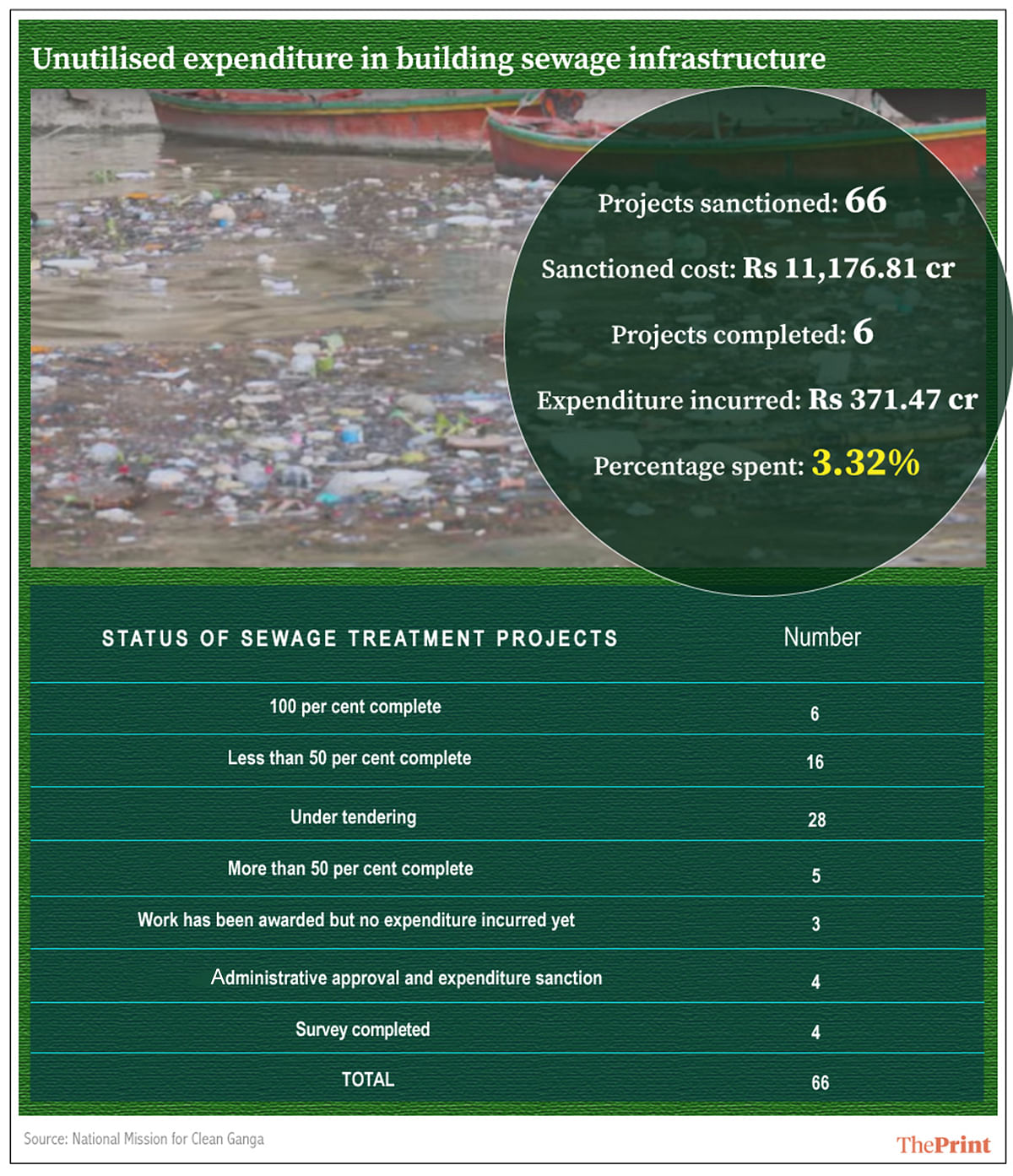
According to an NMCG official, the delay can be attributed to the fact that in the first two years of the Namami Gange programme — from 2015 to 2017 — an attempt was made to understand why older sewage treatment plants hadn’t functioned optimally.
“For example, now we have decided to switch to a ‘hybrid annuity model’ instead of DBOT (design, build, operate and transfer) model. Under the new model, 60 per cent of the payment to the operator will be spread over 15 years, thus ensuring accountability,” he said.
NMCG, the nodal agency for implementing the Ganga cleaning project, also introduced the concept of ‘one city, one operator’ to improve coordination among various bodies.
According to Shashi Shekhar, former secretary, ministry of water resources, many projects were tendered “very recently” because states didn’t cooperate initially.
“Initially, the new projects based on hybrid annuity model and ‘one town, one operator’ met with a lot of resistance from states,” he said.
“State agencies wanted to implement the new projects themselves. It was after the new governments were elected in Uttarakhand and Uttar Pradesh that the states came onboard,” Shashi Shekhar added.
Both UP and Uttarakhand elected BJP governments to power in March last year.
On average, it takes 24 months to get a sewage treatment plant (STP) to be fully functional after a year-long tendering process gets over.
According to a former NMCG official, another factor that delayed the project was that then water resources minister Uma Bharti was keen on giving the projects to the states for implementation, but senior NMCG officials had opposed the idea.
Also read: Fact check: Arun Jaitley claims in Budget that Ganga cleanup has picked up speed. It hasn’t
“This led to a lot of back and forth. The process got delayed by more than a year,” he added.
The official also pointed out that most states are not capable of executing projects, lack the required funds and “suffer from rampant corruption”.
The former NMCG official also said that because of this a lot of time went into ensuring NMCG became a more empowered organisation, “insulated both from the ministry and the minister” and had the authority to sanction large-scale projects.
Institutional development
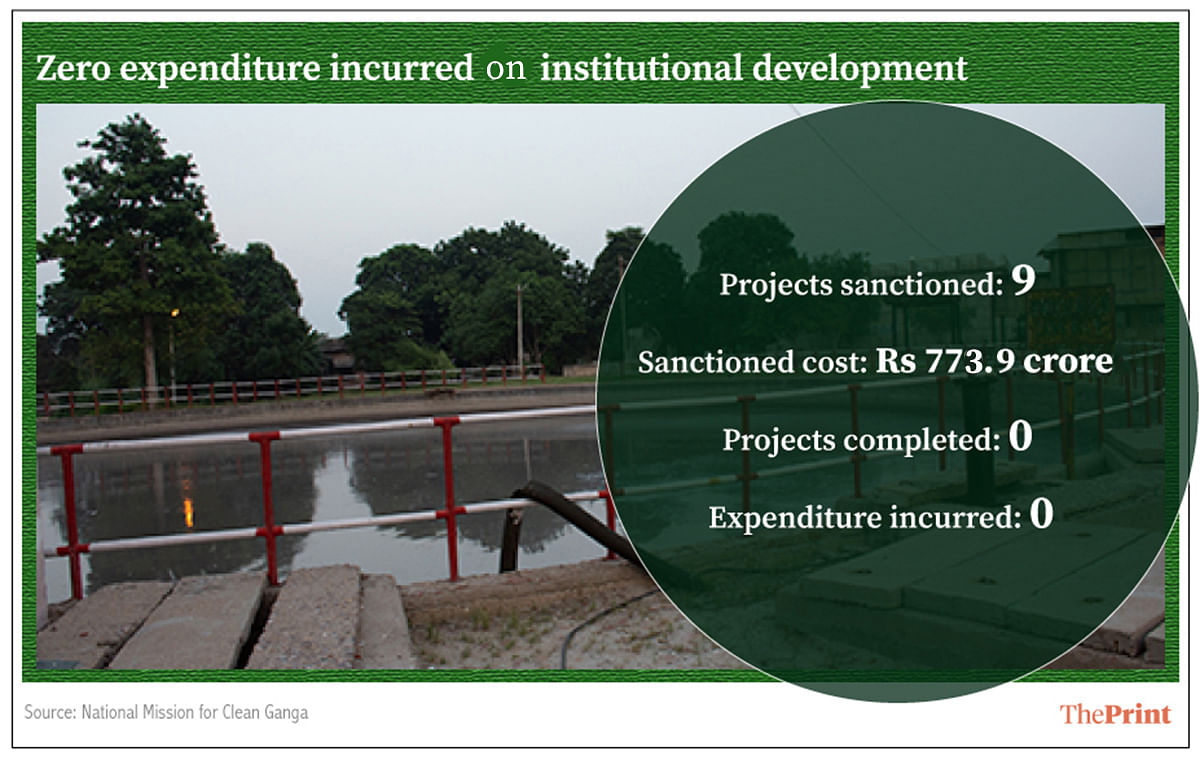
Under this, a total of nine new projects have been envisaged at a cost of Rs 773.9 crore. No expenditure has been incurred on these projects until now even though Rs 21.12 crore has been released.
According to the report, Rs 639.97 crore will be given to the Central Pollution Control Board for strengthening its laboratories across states and for setting up a CETP (common effluent treatment plant) in Jajmau on the outskirts of Kanpur to deal with the waste generated by the tanneries in the city.
The administrative approval and economic sanction for the same came through only in June this year and no money has been spent on these projects yet.
According to the NMCG official, these projects were sanctioned last year but there was a lack of clarity on how to proceed with them.
“It was unclear whether the money was to be given to the states for setting up labs,” he said.
“In addition, World Bank funding is also there, so it becomes a sensitive issue. We have to follow their technical specifications and procurement guidelines,” the official added.
However, a former CPCB official claimed NMCG assumed that state boards had the capacity to set up the laboratories themselves, which delayed the project.
Of the total sanctioned amount, Rs 554.00 crore will be spent on setting up the CETP in Jajmau. Tanneries have long been considered a major polluter of the Ganga, discharging at least 50 MLD of untreated waste into the river.
According to Shashi Shekhar, for many years, NMCG had been unable to reach an agreement with the state authorities on what to do with the tanneries.
“The suggestion was to dilute the waste. But we wouldn’t be able to measure that,” he said.
“Whenever there is a hard decision to make, states have their vested interests…also some of the tanneries had political patronage and held the whole thing to ransom,” Shashi Shekhar claimed.
“SPCB wasn’t supporting us. We had to go through various complications to make sure that the environment was conducive,” he added.
Another project envisaged is the establishment of Ganga monitoring centres. No funds have been released for this yet. According to the report, an annual plan for this has been developed and the process to set up a technical committee is underway.
Two of the new projects are aimed at using archival images to reconstruct the Ganga of the past and to create a database of high-resolution images of the Ganga basin. The report maintains that this project is underway.
Project implementation support and research projects
Under this, about 22 new projects have been sanctioned at a cost of Rs 353.53 crore, out of which Rs 93.38 crore has been spent so far. This component mainly includes initiatives such as biodiversity conservation, afforestation and research projects.
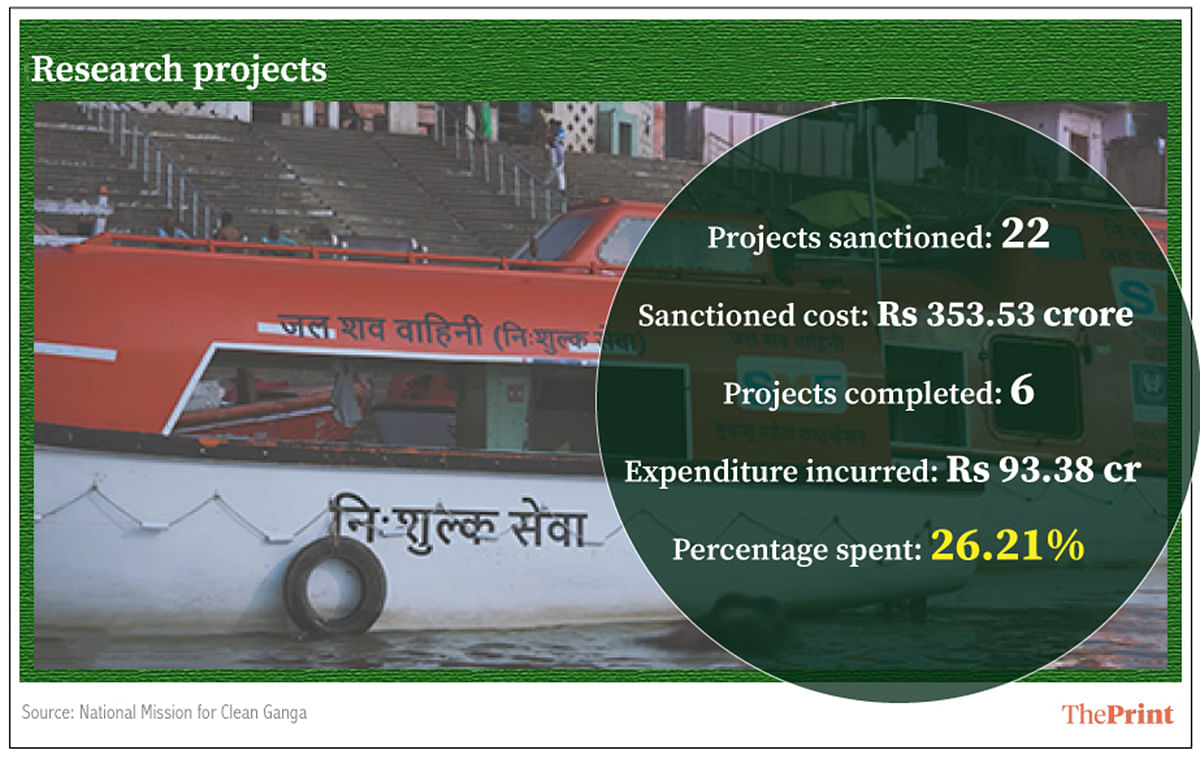
This also includes a project worth Rs 7.69 crore, primarily aimed at establishing a monitoring centre and rescue and rehabilitation centres for aquatic wildlife. Of this, Rs 3.12 crore has been spent so far. The progress mentioned in this regard, however, only refers to the celebration of the World Environment Day at the Wildlife Institute of India in June this year.
According to the NMCG official quoted above, this might only describe the progress achieved in a particular month. A look at an earlier NMCG report published in May too, however, shows similar results — it mentioned a five-day workshop on biodiversity conservation and the celebration of the World Forestry Day and the World Water Day.
Similarly Rs 17.14 crore has been sanctioned for “planning the restoration of aquatic species” which will include community-based conservation programmes. Of this, Rs 7.11 crore has been spent so far. The progress described in this regard, however, only mentions a two-day training workshop for officials of Narora Atomic Station in UP and staff of the forest department on ‘aquatic species conservation and Ganga rejuvenation’.
Also read: A Modi promise not kept: Images reveal how a pure Ganga turns disgustingly brown
Another official at NMCG, however, claimed that there is extensive work being done for the preservation of biodiversity which so far includes a baseline survey of the wildlife, collecting data and “training thousands of people”.
Ghats and crematoria
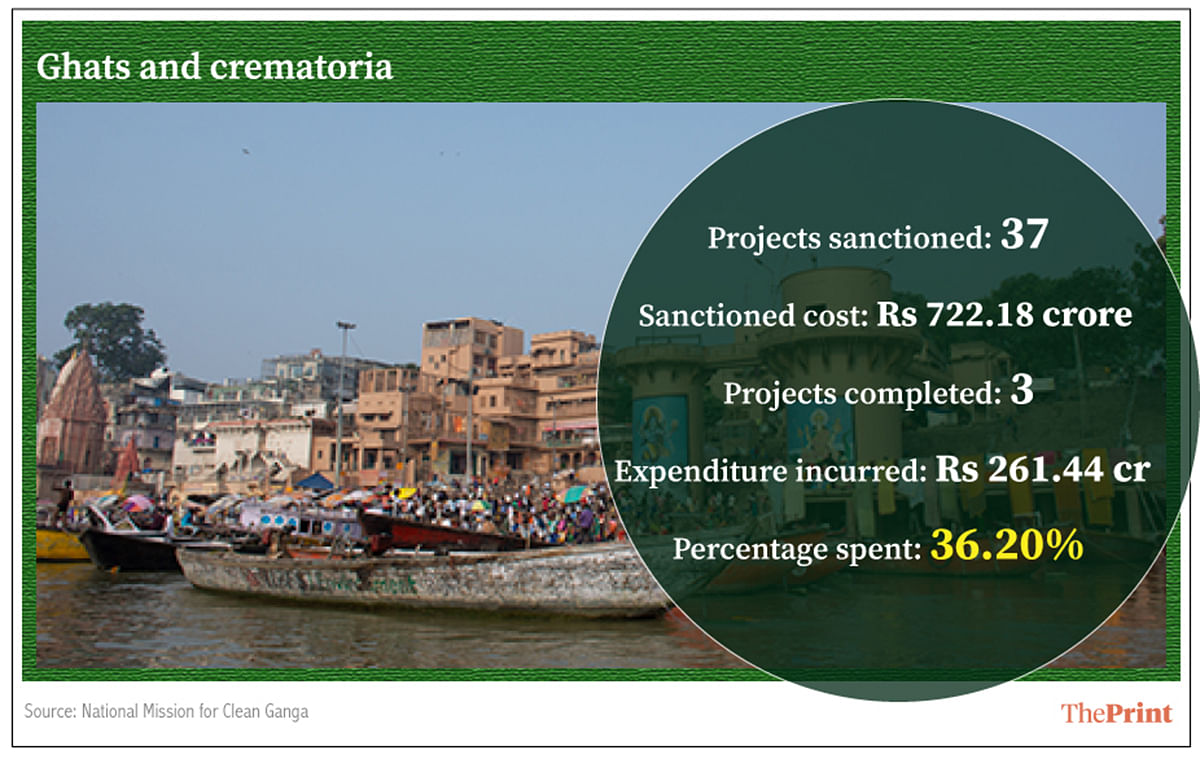
A total of 37 projects related to the construction of new ghats and crematoria as well as the revamp of existing ones have been conceived under Namami Gange. Of these, three projects have been completed so far while four are still under tendering process. Out of the sanctioned money of Rs 722.18 crore, Rs 261.44 crore has been spent so far.
According to the NMCG official, 151 new ghats are being constructed, of which 36 ghats have been completed. The rest will be ready by the end of this year, the official said.
Cleaning of ghats
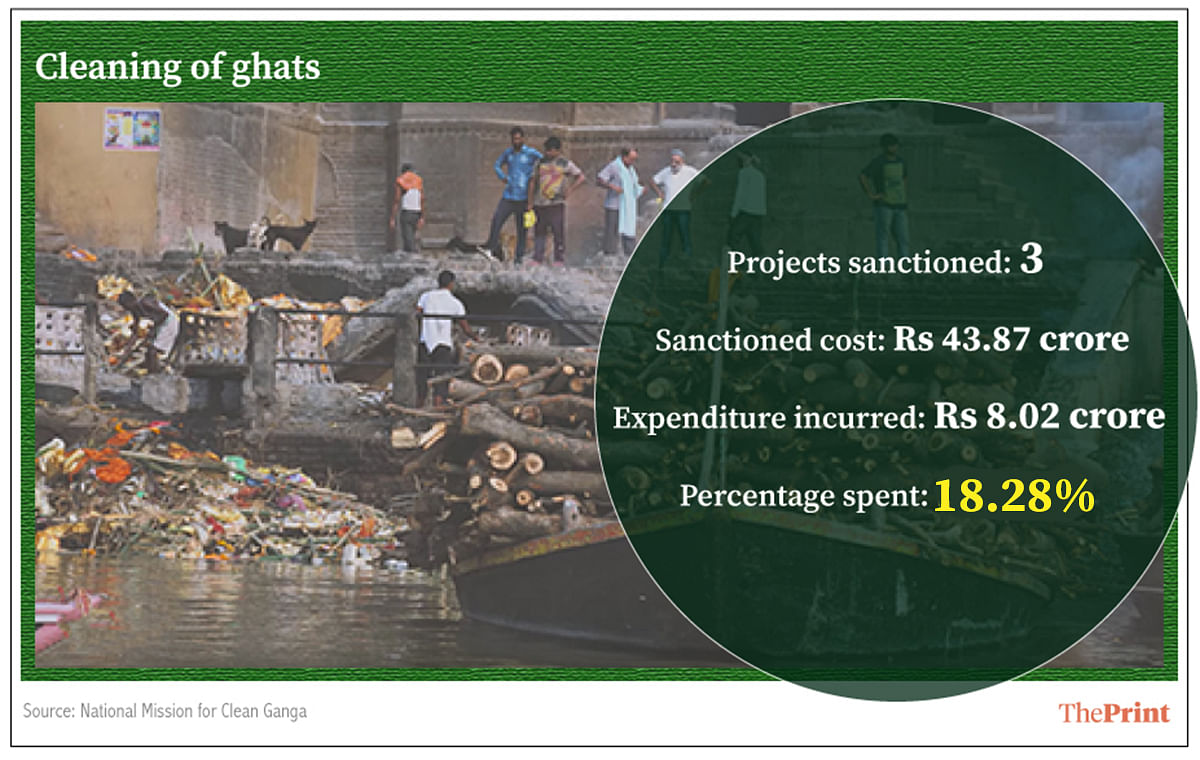
This includes three projects aimed at cleaning the 84 ghats in Varanasi, 72 in Haridwar and four in other cities along the Ganga.
A total of Rs 43.87 crore has been sanctioned for this project, out of which Rs 8.02 crore has been spent on cleaning the ghats in Varanasi. For the other ghats, only the administrative approval and expenditure sanction has been granted so far.
Asked why ghat cleaning been taken up in a staggered manner, the NMCG official said that the project in Varanasi was the first of its kind and considering the progress it made, a decision was made to extend it to other cities.
River surface cleaning
This involves the use of trash skimmers to clean the river. The sanctioned cost for this is Rs 55.24 crore, of which only Rs 2.05 crore has been spent.
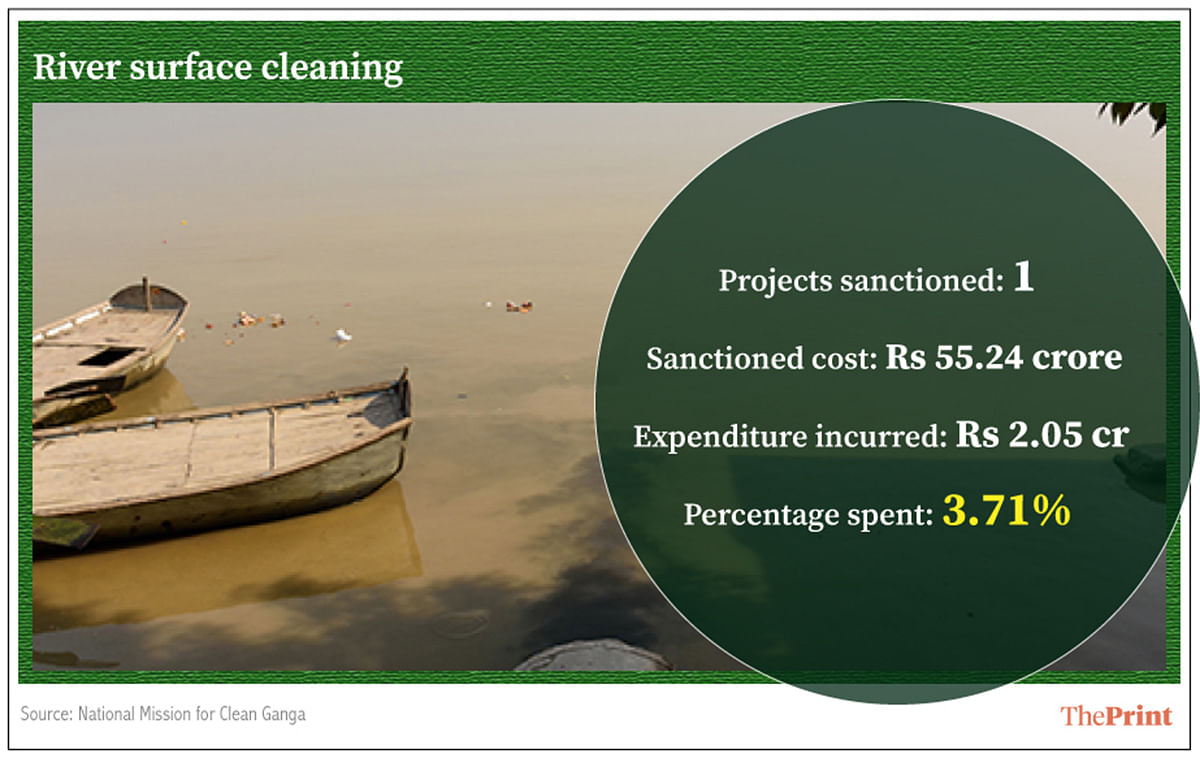
Composite ecological task force (CETF)
The report mentions the creation of a task force comprising ex-servicemen under the Namami Gange programme. It will be involved in activities such as plantation of trees, patrolling of sensitive areas along the river for biodiversity protection and monitoring the river for pollution.
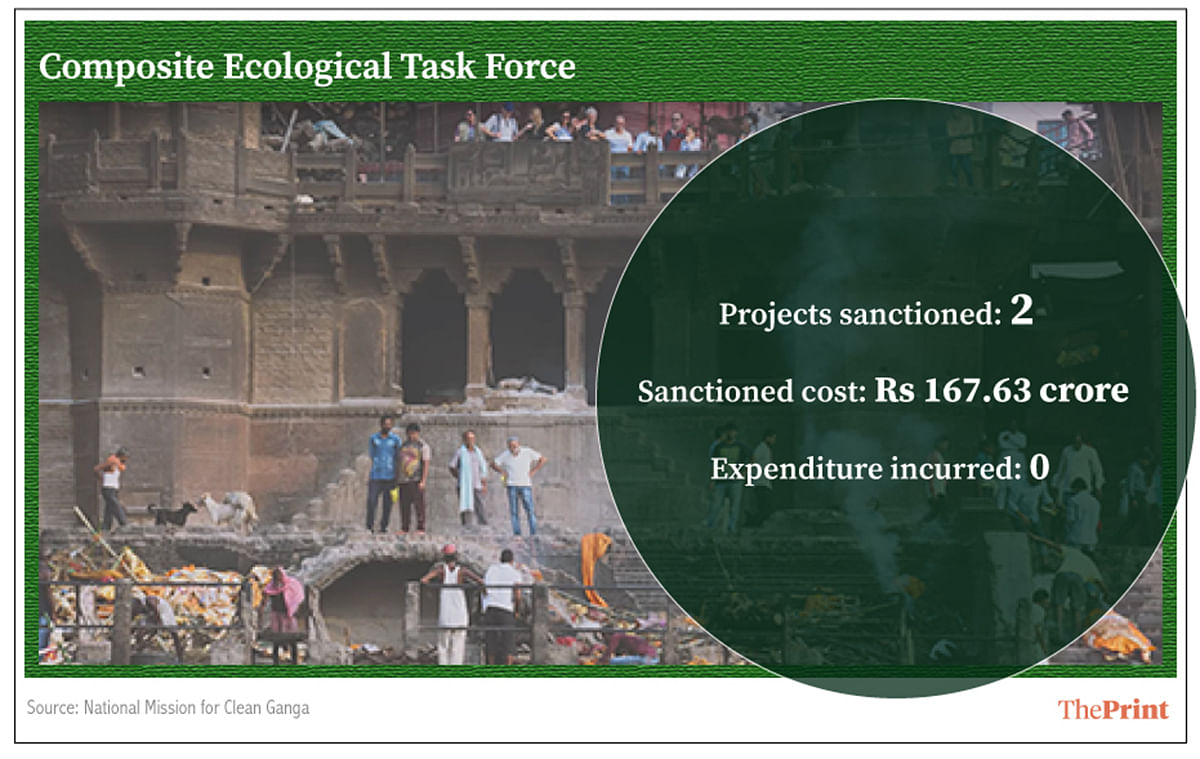
No expenditure has been incurred out of the sanctioned Rs 167 crore on the CETF until now. The report, however, mentions that 141 people have come forward to be part of CETF.
Shashi Shekhar said, it is unclear under what law the taskforce will be empowered to perform its duties.
Bioremediation
According to the report, the Namami Gange programme includes eight projects for bioremediation — the process of using naturally occurring microbes for accelerating the breakdown of pollutants.
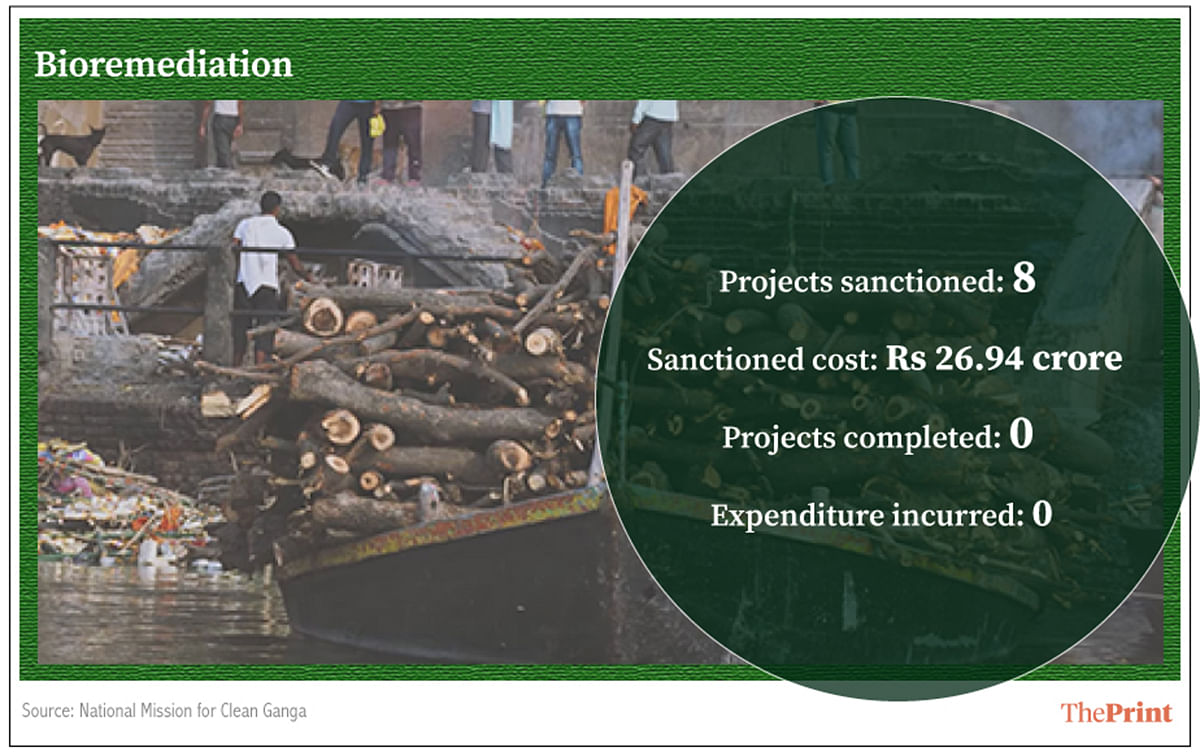
A total of Rs 26.94 crore has been sanctioned for this but no money has been utilised to date despite the fact that all eight projects have received administrative approval.
Bioremediation is being used only on an experimental basis currently, the NMCG official claimed.
Construction of toilets in villages near Ganga
Under this scheme, spearheaded by the ministry of drinking water and sanitation, more than 10 lakh latrines have been constructed in 4,465 villages near the Ganga. The sanctioned cost of this is Rs 1,426.26 crore, of which Rs 953.00 crore has been spent so far.
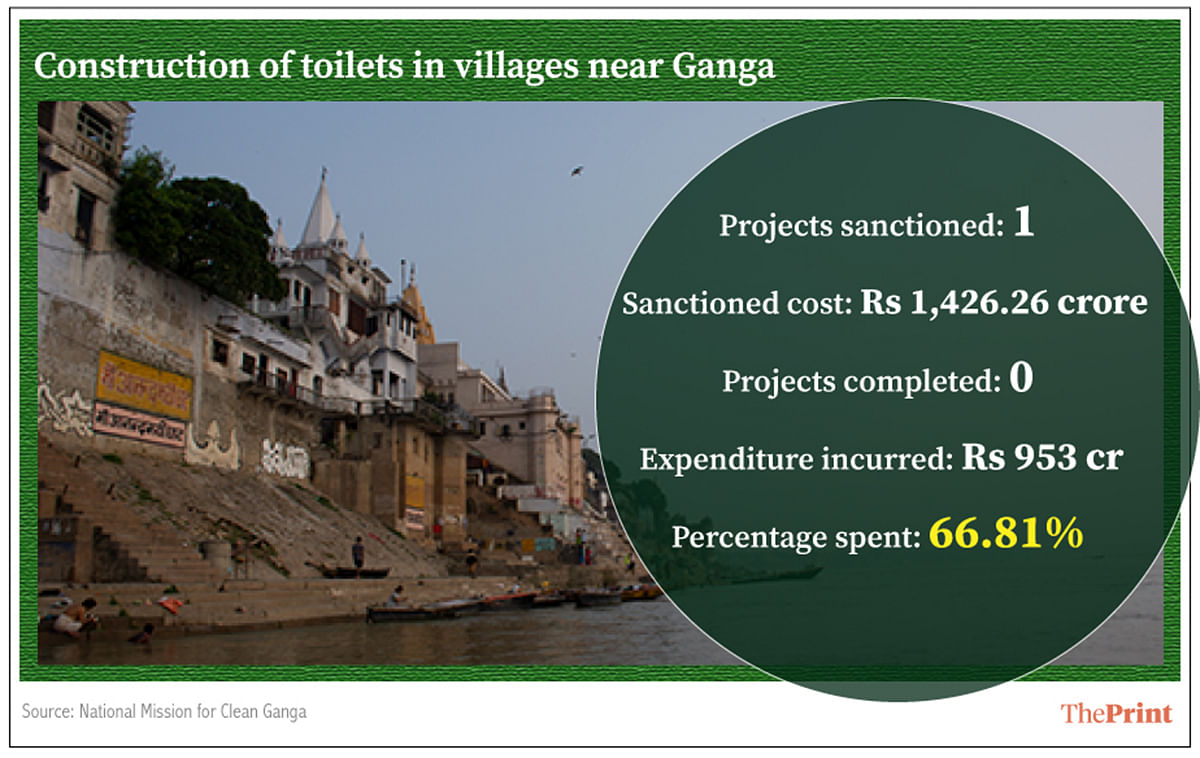
Previous NMCG reports also mentioned a UNDP-run project, aimed at improving rural sanitation in Jharkhand which had been closed. A sum of Rs 127.83 crore was sanctioned for this, of which Rs 5 crore was spent.
The road ahead
In fact, NMCG data accessed by ThePrint shows that Namami Gange got off to a slow start, picking up pace only in 2017-2018.
Only five new projects were approved in 2015-2016 and the expenditure incurred by NMCG was Rs 602.60 crore. The number peaked to 36 projects and expenditure went up to Rs 1,625.11 crore in 2017-2018.
According to a senior NMCG official, things changed substantially after October 2016, when NMCG was empowered to sanction projects up to Rs 1,000 crore. This, according to him, explains why a majority of the projects have been sanctioned in 2017.
“Now, we (NMCG) can sanction projects. The file does not have to move from one place to another,” he added.
Further, it took at least two years to get clarity and plan how to proceed with new projects, he said.
According to a former NMCG official, another reason for the Namami Gange’s now accelerated pace is the speedy decision-making process.
Also read: Ganga cleaning agency to spend Rs 3 crore to build its social media image
“The decision-making process has become much faster now. His (Gadkari’s) main challenge is dealing with environmental flow of the Ganga,” he added.
For 2018-19, NMCG has approved four new projects and the overall expenditure incurred is Rs 825.35 crore until August. The projected expenditure for this year is Rs 3,100 crore.
However, despite all this, experts have expressed reservations about Ganga being clean by 2020.
“The government is beating around the bush and not hitting on the core issue,” said Mallika Bhanot, member of Ganga Ahvaan, a citizens’ forum.
“The flow of the river has been severely compromised. It is not possible to fulfill the aim of rejuvenation until they address this issue,” she added.
Echoing a similar view, Shashi Shekhar said while NMCG could be able to complete most projects by 2020, it is doubtful whether the river will be really clean by then.
“How much water does the Ganga have? The solution to pollution is dilution (of sewage) or ensuring increased flow of water,” he added.


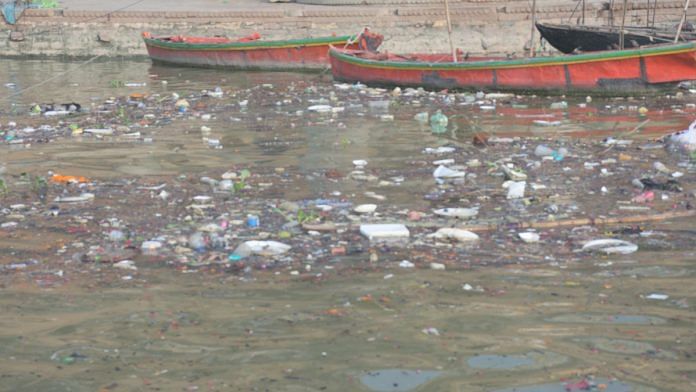

Major focus today is on cleaning the river stopping effluents than increasing the flow. This is indeed a correct strategy. Removing the cause if the problem rather than curing the symptoms with dilution.
The 80: 20 Pareto approach tells that 80 percent of the sewage is being duscharged from 20 percent of the outlets which flow into the river.. Tge low lieing fruits have been identified and focus is to build facilities around the 20 percent if major sewage and effluent outlets. The expenditure is also being monitired on these plants.
Hence Nitin Gadkari is right that 80 percent of the cleaning will be completed by 2019 March.
Recent success in the first werk of Dec 2018 ad a result of diverting the Kanpur drains contributing 140 milluon litres per day and diverting the Effluent from Tanneries draining into Ganges have given immediate results in terms of the increase in oxygen levels in the river.
I for one am very hopeful that we now have a Triad of Yogi Adityanath Nitin Gadkari and Narendra Modi supported by Trivendra Singh Rawat, Nitish Kumar and Mamata Banerjee working to achieve this century old dream & they can make the dreams of millions of Indians come true finally… a pure and clean Ganges the lifeline of India!
I think the Plan of Action and implementation on the Ganges issue continues to suffer the deleterious effects of India’s unsuccessful way of implementing government projects. Now the Minister overseeing this project wants to make Ganga a ‘Waterway’. Sadly, this state of affairs is not good for the people of India. The clean water scarcity will be a major problem as India pushes for growth and Ganga struggles to survive.
I was there a couple of months back and was startled to see how reckless and ruthless we humans can be. Was shocked to see the ganga the way it is. This article too seems to delve in criticism of Modi and his government than being positive about things being done. Till such time the people living along the Ganga and people visiting it do not turn a new leaf, we would hardly witness any improvement. Its not just money, there is a need for the mindset to change.
Gadkariji/ Modiji sorry not good performance for River Ganga, unlike good work of National highways. Thanks to Umaji and also Modiji who chose and wasted first 3 years.
Gadkari was only in charge for a year. That is where most of the progress has been made, in the last year. Modi got rid of the other minister due to non-performance.
Actually govt should have set specific feasible target with deadline of Dec 2018 and then give its progress details sothat voters can decide about govts sincerity. You and Modiji have done good job in National highways but not happy with River Ganga project, courtesy Umaji and Modiji who selected this bad performer and wasted nearly 3 years
Sewage treatment is key to the success of this programme. The year 2020 is not sacrosanct, but good quality work should be done, which will endure.